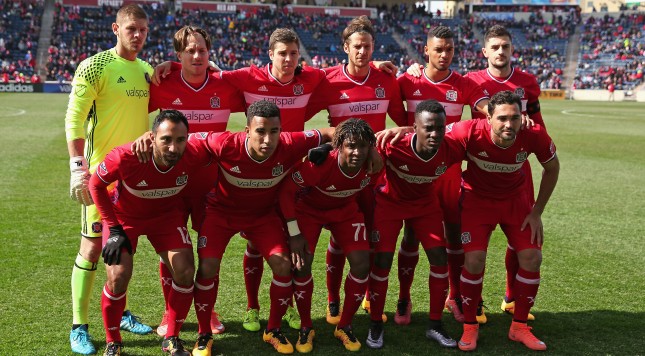Nobody gave up more goals last year than the Chicago Fire. Their defense was shambolic in their twenty-loss season. When they started off the new season by surrendering four goals at home to New York City FC, it looked like it would be more of the same.
However, since that match, everything has changed. The Fire have surrendered just one goal since opening day, and that was in the second match of the season. Their past three matches have been the definition of defensive perfection. But it is the manner in which they have achieved this level of defensive solidity that is rather remarkable.
It’s hard to say that consistency is the key, because Veljko Paunovic has used two different formations with two different collections of defenders in those four games. But the fact remains that this Fire defense has been the best defense in MLS in the past four weeks.
It hasn’t come against easy teams either. A 10-man Fire kept Orlando City scoreless for an hour to hold onto a 1-1 draw – at the Citrus Bowl. They then shut out defending MLS Cup runner-ups Columbus Crew before beating upstarts Philadelphia Union 1-0. Then, in the most dramatic clean sheet of them all, Chicago turned around their 4-3 home loss to the boys in blue and traveled into New York, where they drew 0-0. You could even make the point that they should have won, as they had a goal disallowed.
Head coach Veljko Paunovic has been thrilled with his team’s turnaround.
“I think our first game, we took our notes from where we need to improve so it’s a big thing,” he said, via Goal.com. Paunovic, like NYCFC head coach Patrick Vieira, is in his maiden voyage in a league that has a history for battering foreign managers. But clearly what Paunovic is teaching is jiving with the players, because the turnaround has been quick and conclusive.
Paunovic had similar things to say after the Columbus draw.
“You have to build your team with a good defense and then improve from that point,” he noted, via MLSsoccer.com. He went on, “We’ve improved defensively—now the next step, possession, reorganization, and scoring.”
Highlighting what has gone right since opening day is fairly easy. First of all, the defense knows their roles, no matter their formation. Look at any heat map of Chicago’s defense in the past four matches and you will see a multicolored glob that spans from touchline to touchline, but the colors are pretty solid all the way through.
That means that the defense is staying home. They aren’t overly pushing forward or getting caught out of position. The only time they were, as the heat map will indicate – was against NYCFC on opening day.
But the credit doesn’t all belong to the back four. Michael Stephens and Matt Polster have been anchoring the midfield with some serious determination. Consider what they did at Yankee Stadium. Stephens made five successful tackles, four of which came in his own half. Each one was directly in front of a different defender, as his impact spread all the way across the pitch.
Polster, meanwhile, has become a connoisseur of the interception, as he averages over five interceptions per match. Perhaps unsurprisingly, on opening day, Stephens was an unused sub. It’s no coincidence that the addition of Stephens to partner with Polster has solidified the defense.
The fact that this Chicago Fire defense has been able to deliver four straight defensive masterclasses with rotating personnel highlights the fluidity that Paunovic has created. He has plenty of defensive quality on this team and this recipe that he is sticking with will continue to deliver.
Now all they need is a little prowess going the other way. Thankfully, Accam is in the ‘final phase’ of recovery. The Fire could soon join the Union as unlikely contenders this MLS season.




















